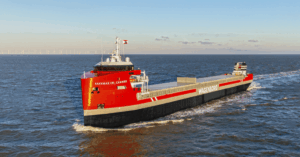Europe Set To Launch Its First Offshore Carbon Dioxide Carrier
Europe is preparing to launch its first offshore carbon dioxide (CO₂) carrier. The vessel, built entirely at the Royal Niestern Sander shipyard in the northern Netherlands, will be officially christened and launched on May 14.
This dedicated CO₂ carrier is part of Project Greensand, which aims to create the European Union’s first full-scale CCS value chain.
The vessel is specifically designed to transport liquefied CO₂ from onshore capture facilities to offshore storage locations in the Danish sector of the North Sea.
The construction of the vessel is a major achievement for both INEOS Energy and Wagenborg Offshore, the project’s key partners.
All sections of the ship have now been completed and assembled, moving the project into its next construction phase. This includes retrofitting, equipment installation, testing, commissioning, and eventual sea trials.
According to INEOS Energy Europe’s CEO, Mads Gade, the completion of the vessel’s structure is a significant development in the EU’s efforts to move captured CO₂ safely and efficiently.
Gade added that the vessel is critical to the company’s goal of launching the EU’s first full CO₂ storage facility, and that Project Greensand is now a step closer to achieving that vision.
Wagenborg Offshore’s Director, Edwin de Vries, emphasised that this is the first vessel of its kind to be built in the European Union. He also confirmed that the construction is progressing according to schedule.
The vessel will operate regular transport routes from Port Esbjerg in Denmark to the Nini West offshore platform, where CO₂ will be injected around 1,800 meters beneath the seabed into the Nini reservoir.
These geological layers have held hydrocarbons for millions of years and have been certified for secure, long-term CO₂ storage.
Gade explained that the geology in the Danish part of the North Sea is well-suited for this type of storage. He added that using this capacity can significantly support both Denmark’s and the EU’s climate goals, and that the new vessel will be central to enabling this development.
This ship is engineered to meet high safety and environmental standards and includes specialised cooling and pressure systems tailored to transporting liquefied CO₂.
The foundation for this milestone was laid in November 2024 when INEOS and Wagenborg signed the agreement for the vessel’s delivery.
The ceremony was witnessed by His Majesty King Willem-Alexander of the Netherlands and His Majesty King Frederik of Denmark.
The vessel’s completion also comes after INEOS, together with Harbour Energy and Nordsøfonden, made the final investment decision in December 2024 to proceed with full-scale CO₂ storage operations in the Nini Field.
The project is expected to begin injecting CO₂ by late 2025 or early 2026.
Initially, Project Greensand aims to store 400,000 tonnes of CO₂ per year, and to increase that capacity to 8 million tonnes annually by 2030.
The dedicated carrier is a critical component in achieving these targets, enabling safe, consistent, and scalable transport of captured CO₂ from across Europe to the Danish site.
Earlier this year, the successful and safe delivery of the ship’s aft section marked another crucial step in the project’s steady progress.
Reference: ineos

